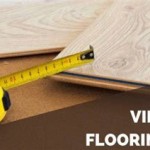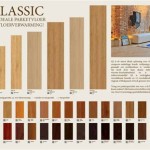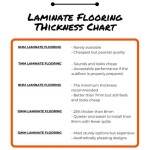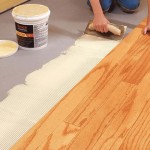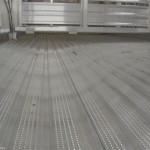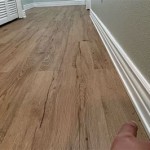Laminate Flooring: A Realistic Alternative that Mimics Real Wood
Laminate flooring has undergone a significant evolution in recent years. Once considered a budget-friendly, but visibly artificial, alternative to hardwood, modern advancements in manufacturing and printing technologies have blurred the lines between laminate and solid wood flooring. The result is a flooring option that convincingly replicates the aesthetic appeal of natural wood while offering a range of practical benefits.
The enhanced realism of laminate flooring stems from a combination of factors, primarily improvements in the photographic imagery used for the decorative layer and the texturing applied to the surface. These advancements, along with considerations of board dimensions and edge detailing, contribute to a final product that is often difficult to distinguish from genuine hardwood at first glance. This article will explore the key features that contribute to laminate's ability to mimic real wood, examining the technological advancements and design considerations involved.
High-Resolution Imaging and Realistic Wood Grain Patterns
The decorative layer of laminate flooring, the layer responsible for its visual appearance, is created using high-resolution photography of actual wood planks. Manufacturers meticulously select various wood species and individual planks with desirable grain patterns, knots, and color variations. These planks are then digitally photographed with advanced imaging equipment, capturing the intricate details and nuances of the wood's natural texture and color.
The resulting high-resolution images are then printed onto a durable paper substrate, which forms the decorative layer. This printing process utilizes sophisticated inks and printing techniques to accurately reproduce the colors, tones, and grain patterns of the original wood. The level of detail captured in these images is significantly greater than in older laminate flooring products, resulting in a more realistic and convincing wood appearance.
Furthermore, many laminate flooring manufacturers now utilize multiple unique images within a single product line. This means that there are fewer repeating patterns across the installed floor, which further enhances the realism. In older laminate flooring, the repetition of the same pattern every few planks was a telltale sign of its artificial nature. The introduction of multiple unique image variations eliminates this visual cue, making the flooring appear more organic and less manufactured.
The selection of wood species that are emulated in laminate flooring is also expanding. Beyond the traditional oak and maple patterns, consumers can now find laminate flooring that replicates exotic hardwoods like acacia, Brazilian cherry, and reclaimed barn wood. This wider variety of options allows homeowners to achieve the desired aesthetic for their homes without the potentially high cost and maintenance associated with these specific wood types. The ability to realistically simulate the visual characteristics of these diverse wood species is a testament to the advancements in photographic and printing technologies.
Embossed-in-Register Texturing for Enhanced Realism
While high-resolution imaging is crucial for replicating the visual appearance of wood, the texture of the flooring plays an equally important role in creating a realistic feel. Embossed-in-register (EIR) technology is a key innovation that allows laminate flooring to mimic the feel of natural wood more closely.
EIR involves aligning the texture of the laminate flooring with the printed grain pattern. This means that the surface texture precisely matches the visual texture of the wood grain, knots, and other details in the decorative layer. For example, if the printed image shows a knot in the wood, the surface of the laminate will also have a corresponding indentation or raised area that mimics the feel of a real knot. This tactile element significantly enhances the realism of the flooring, making it feel more like natural wood underfoot.
The EIR process requires precise synchronization between the printing and embossing stages of manufacturing. This level of precision was not possible with older laminate flooring production methods, which resulted in a smoother, less realistic surface texture. The introduction of EIR technology has been a major factor in improving the overall realism of laminate flooring, bridging the gap between visual appearance and tactile feel.
Different types of EIR textures are available, ranging from subtle wood grain textures to heavily distressed textures that replicate the look and feel of reclaimed wood. Consumers can choose a texture that complements the printed wood grain pattern and matches their desired aesthetic. The availability of these varied textures further enhances the versatility of laminate flooring, allowing it to mimic a wider range of wood types and styles.
Board Dimensions, Edge Detailing, and Installation Techniques
Beyond the decorative layer and surface texture, other factors contribute to the overall realism of laminate flooring. These include the board dimensions, edge detailing, and installation techniques used to create the finished floor.
The dimensions of laminate flooring planks are becoming increasingly varied to mimic the look of real hardwood. Wider planks, longer planks, and planks with varying widths are all available, allowing for greater design flexibility and a more realistic appearance. The use of wider planks, in particular, can create a more modern and upscale look, as they are often associated with higher-end hardwood flooring.
Edge detailing also plays a significant role in the realism of laminate flooring. Beveled edges, which are slightly angled edges on each plank, create subtle grooves between the planks when installed. These grooves mimic the look of individual hardwood planks and add depth and dimension to the floor. Micro-beveled edges are even smaller and more subtle, creating a more refined and understated look. Square edges, on the other hand, create a seamless, more contemporary appearance.
The installation technique used to install laminate flooring can also impact its overall appearance. While laminate is typically installed as a floating floor, meaning it is not directly glued or nailed to the subfloor, proper preparation of the subfloor is essential to ensure a smooth and level surface. Uneven subfloors can result in gapping between planks or an uneven appearance, detracting from the realism of the flooring. Using a high-quality underlayment can also help to improve the sound insulation and cushioning of the floor, further enhancing its comfort and feel.
Staggering the end joints of the planks during installation is also crucial for creating a natural and random appearance. Randomly staggering the joints prevents the creation of repeating patterns, which can be a giveaway that the flooring is not real wood. Following proper installation guidelines and paying attention to these details can significantly enhance the overall realism and aesthetic appeal of laminate flooring.
In conclusion, the advancements in laminate flooring technology have created a product that convincingly mimics the look and feel of real wood. High-resolution imaging, embossed-in-register texturing, and attention to detail in board dimensions and edge detailing all contribute to the realism of modern laminate flooring. These factors combine to offer homeowners a durable, affordable, and aesthetically pleasing alternative to traditional hardwood flooring.
The benefits extend beyond just aesthetics. Laminate is generally more resistant to scratches, dents, and fading compared to hardwood, making it a good choice for high-traffic areas or homes with pets and children. Its ease of installation, often employing a click-lock system, also makes it a popular choice for DIY enthusiasts. And, of course, the cost-effectiveness of laminate allows homeowners to achieve the desired wood look without the significant investment required for genuine hardwood.
The continued evolution of laminate flooring suggests that its ability to mimic real wood will only improve in the future. As technology advances and manufacturers continue to refine their processes, laminate flooring will likely become an even more compelling alternative to natural wood for homeowners seeking a balance of aesthetics, durability, and affordability.

Engineered Flooring Vs Laminate Everything You Need To Know Forbes Home

2024 Laminate Flooring Trends 10 Stylish Ideas

Laminate Vs Hardwood Flooring Major Differences Forbes Home

Laminate Floor Guide Lowe S

Laminate Flooring The Home Depot

Best Wood Look Flooring Options America

Laminate Flooring Types And S Forbes Home
Vinyl Flooring That Looks Like Wood
Vinyl Flooring That Looks Like Wood

Types Of Laminate Flooring The Home Depot
Related Posts

